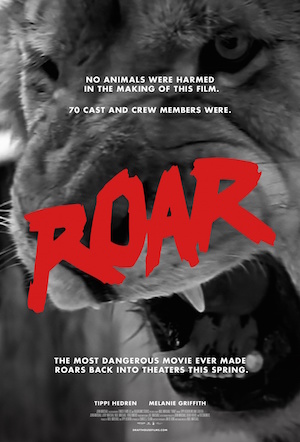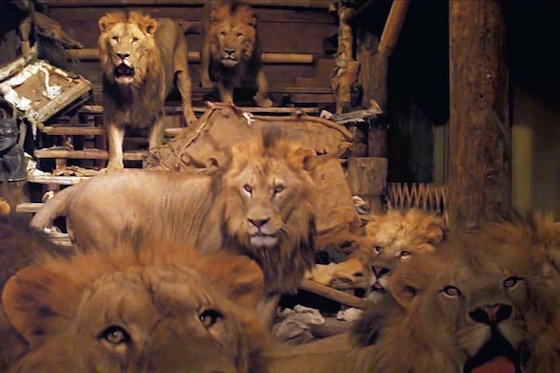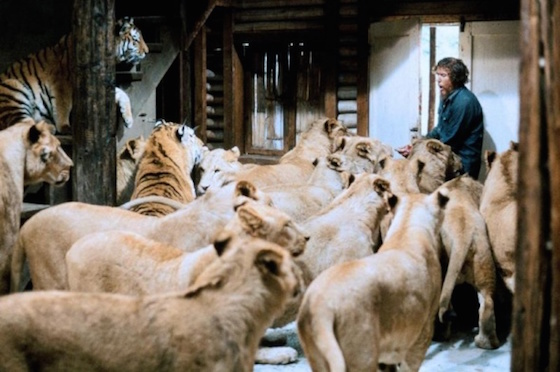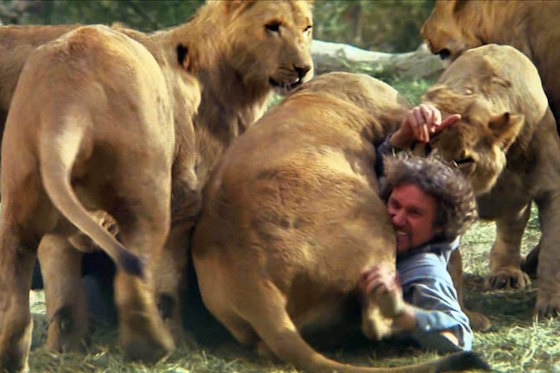 Check out David Allegre’s interview with Roar crewmember Terry Albright here.
Check out David Allegre’s interview with Roar crewmember Terry Albright here.
[Rating: Minor Rock Fist Down]
Roar is easily one of the most confusing films I have ever watched.
I don’t understand how writer, director, and star Noel Marshall ever thought a film that had dozens of real lions running through a house with terrified humans was a good idea.
I’m not sure why any studio would ever green light such a project, though I would have loved to have heard that pitch session.
When the numbers of expected on set injuries started to mount, I have no clue why cast and crew continued to return to the production.
I just have no idea how this film ever came into existence.
It is not as though the plot of Roar is brilliant either. Hank (Marshall), a happy go lucky conservationist, lives on a wildlife reserve with dozens of large predatory cats. Tigers, lions, panthers, cheetahs all gather in and around Hank’s house and live in “peace” and “harmony” with the enthusiastic scientist. All would be well, if it weren’t for the fact that his neighbors hate the cats and want them all killed. To complicate matters further, Hank’s family is coming to visit him on this African reserve.
 This is family fare, boring and forgettable, or it would be, if Roar weren’t also a terrifyingly dangerous film. The scenes where Noel Marshall runs amidst dozens of lions and tigers are real. So real in fact that Noel Marshall suffered multiple injuries that wouldn’t heal for years after filming concluded.
This is family fare, boring and forgettable, or it would be, if Roar weren’t also a terrifyingly dangerous film. The scenes where Noel Marshall runs amidst dozens of lions and tigers are real. So real in fact that Noel Marshall suffered multiple injuries that wouldn’t heal for years after filming concluded.
Tippi Hedren, who plays Hank’s wife Madelaine, suffered a broken leg and severe bite wound during the production. Melanie Griffith, in the role of Melanie, Hank and Madelaine’s daughter, was mauled by a lion and required fifty some stitches and plastic surgery. A lion scalped Jan de Bont, the cinematographer. That’s right, scalped him.
 Roar is a Benji film, if Benji could kill everyone on set.
Roar is a Benji film, if Benji could kill everyone on set.
Since the plot is so contrived and the shots of lions knocking around humans are so tense, the experience of watching Roar is exhausting. I was tired and relieved at its conclusion. The closest comparison I can make to the experience of watching Roar is watching the Faces of Death films, compilations of news footage and low budget horror film b-roll, that blurred the “real” footage of death with the fictional.
 Most people can skip Roar, but if the confusing anomalies of cinema appeal to you, if the films that should never have existed, yet somehow, here they are, if those films draw you in like a magnet, then you must see Noel Marshall’s cinematic madness on the big screen.
Most people can skip Roar, but if the confusing anomalies of cinema appeal to you, if the films that should never have existed, yet somehow, here they are, if those films draw you in like a magnet, then you must see Noel Marshall’s cinematic madness on the big screen.







Comments on this entry are closed.